 In the blog the service sector continues to drive the UK business cycle written in October 2014 we observed how UK growth was being driven by the service sector while other industrial sectors struggled. The contrasting performance across UK industry appears now to be even more marked. The latest GDP numbers from the Office for National Statistics contained in Gross Domestic Product: Preliminary Estimate, Quarter 4 (Oct to Dec) 2015 show the economy’s output expanded by 0.5 per cent in the fourth quarter. Yet the construction sector is in recession following contractions of 1.9 per cent (Q3) and 0.1 per cent (Q4). Here we update our earlier blog to evidence the UK’s growth paradox.
In the blog the service sector continues to drive the UK business cycle written in October 2014 we observed how UK growth was being driven by the service sector while other industrial sectors struggled. The contrasting performance across UK industry appears now to be even more marked. The latest GDP numbers from the Office for National Statistics contained in Gross Domestic Product: Preliminary Estimate, Quarter 4 (Oct to Dec) 2015 show the economy’s output expanded by 0.5 per cent in the fourth quarter. Yet the construction sector is in recession following contractions of 1.9 per cent (Q3) and 0.1 per cent (Q4). Here we update our earlier blog to evidence the UK’s growth paradox.
Preliminary estimates suggest that the UK economy expanded by 0.5 per cent in the final quarter of 2015 following on from growth of of 0.4 per cent in the third quarter. 2015 as a whole saw output grow by 2.2 per cent, down from 2.9 per cent in 2014 and a little below the average over the past 60 years of around 2.6 per cent.
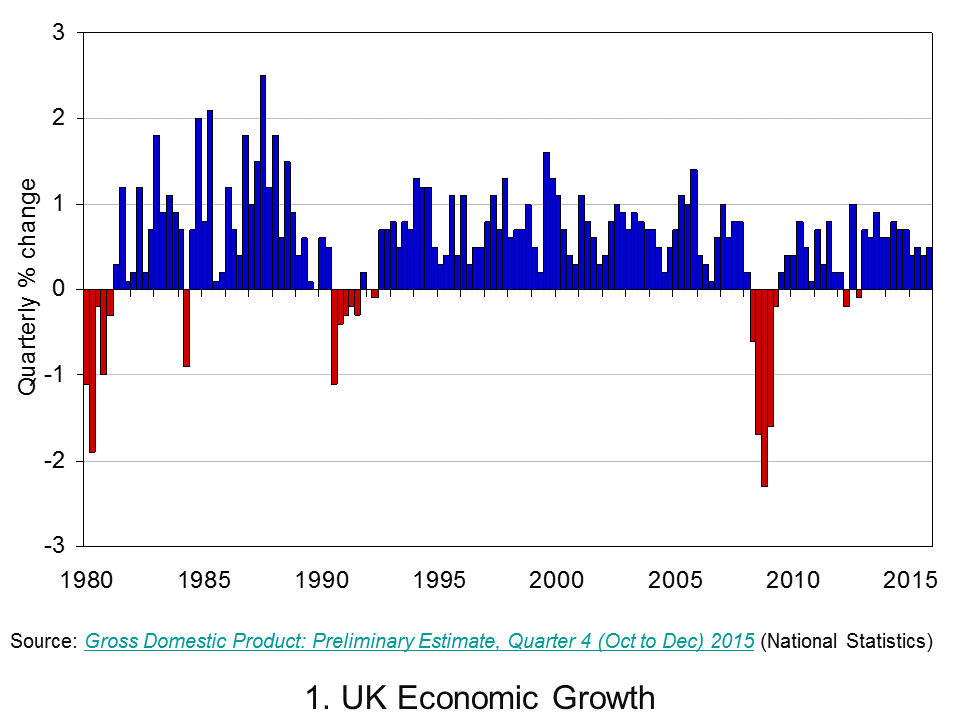 Chart 1 shows quarterly economic growth since 1980s (Click here for a PowerPoint of the chart). It illustrates nicely the inherent volatility of economies – one of the threshold concepts in economics.The average quarterly rate of growth since 1980 has been 0.5 per cent so on the face of it, a quarterly growth number of 0.5 per cent might seem to paint a picture of sustainable growth. Yet, the industrial make up of growth is far from balanced.
Chart 1 shows quarterly economic growth since 1980s (Click here for a PowerPoint of the chart). It illustrates nicely the inherent volatility of economies – one of the threshold concepts in economics.The average quarterly rate of growth since 1980 has been 0.5 per cent so on the face of it, a quarterly growth number of 0.5 per cent might seem to paint a picture of sustainable growth. Yet, the industrial make up of growth is far from balanced.
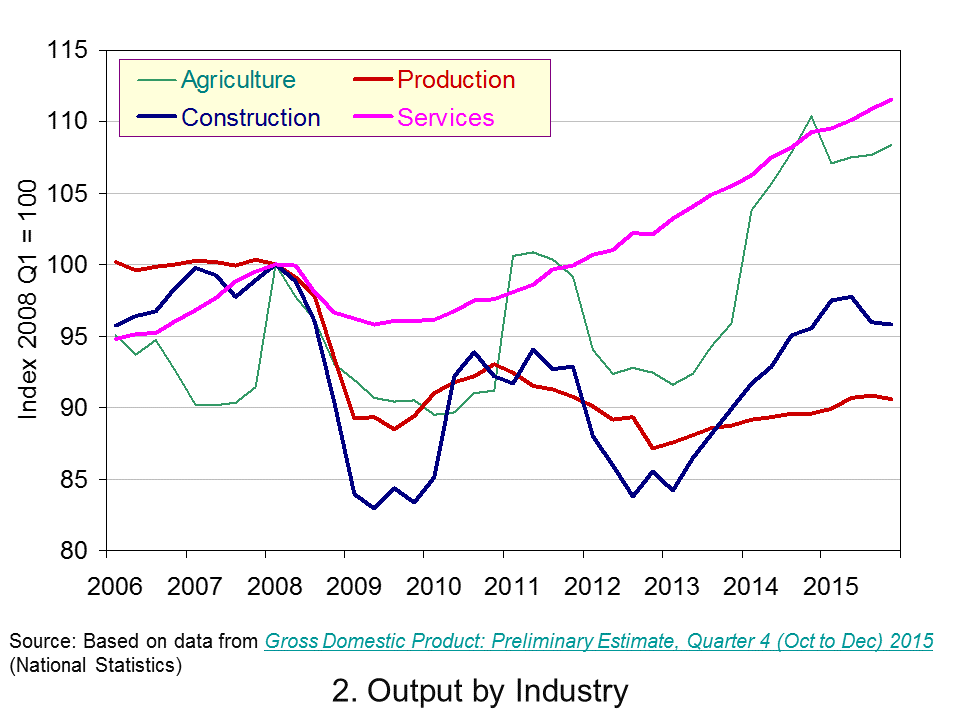 Consider now Chart 2 (Click here for a PowerPoint of the chart). It allows us to analyse more recent events by tracking how industrial output has evolved since 2006. It suggests an unbalanced recovery following the financial crisis. In 2015 Q4 the economy’s total output was 6.6 per cent higher than in 2008 Q1 with service-sector output 11.6 per cent higher. However, a very different picture emerges for the other principal industrial types.
Consider now Chart 2 (Click here for a PowerPoint of the chart). It allows us to analyse more recent events by tracking how industrial output has evolved since 2006. It suggests an unbalanced recovery following the financial crisis. In 2015 Q4 the economy’s total output was 6.6 per cent higher than in 2008 Q1 with service-sector output 11.6 per cent higher. However, a very different picture emerges for the other principal industrial types.
The economy’s total output surpassed its 2008 Q1 peak in 2013 Q2, but output across the production industries in 2015 Q4 remains 9.4 per cent lower than in 2008 Q1 (and 6.4 per cent lower specifically within manufacturing) and 4.2 per cent lower in the construction sector. However, output in the agricultural sector has rebounded and is now 8.4 per cent higher than in 2008 Q1.
The growth data continue to show the British economy struggling to rebalance its industrial composition. With output in construction in 2015 Q4 2 per cent lower than it was in Q2 and manufacturing output 0.4 per cent lower, UK growth remains stubbornly dependent on the service sector.
Data
Preliminary Estimate of GDP – Time Series Dataset Quarter 4 (Oct to Dec) 2015 Office for National StatisticsGross Domestic Product: Preliminary Estimate, Quarter 4 (Oct to Dec) 2015 Office for National Statistics
Economy tracker: GDP BBC News
Articles
UK economic growth slows in 2015: what the economists are saying Guardian, Katie Allen (28/1/16)
UK economy grows 0.5% in fourth quarter BBC News, (28/1/16)
Bumpy times ahead’ for UK even as fourth quarter growth accelerates Telegraph, Szu Ping Chan (28/1/16)
UK economic growth rises to 0.5% in fourth quarter The Scotsman, Roger Baird (28/1/16)
GDP growth picks up to 0.5% but only the services sector comes to the party Independent, Ben Chu (29/1/16)
Questions
- What is the difference between nominal and real GDP? Which of these helps to track changes in economic output?
- Looking at Chart 1 above, summarise the key patterns in real GDP since the 1980s.
- What is a recession?
- What are some of the problems with the traditional definition of a recession?
- Can a recession occur if nominal GDP is actually rising? Explain your answer.
- What factors lead to economic growth being so variable?
- What factors might explain the very different patterns seen since the late 2000s in the volume of output of the four main industrial sectors?
- What different interpretations could there be of a ‘rebalancing’ of the UK economy?
- What other data might we look at to analyse whether the UK economy is ‘rebalancing’?.
- Do the different rates of growth across the industrial sectors of the UK matter?
- Produce a short briefing paper exploring the prospects for economic growth in the UK over the next 12 to 18 months.
- What is the difference between GVA and GDP?
- Explain the arguments for and against using GDP as a measure of a country’s economic well-being.
 Economics, but not as we know it. As the introduction to this programme on BBC radio 4 suggests, there has been criticism and concern about the way in which we think about economics. About, how it’s taught; the lessons we learn and whether we need to have a re-think. Tomas Sedlacek is a Czech economist and has a different way of thinking about this subject.
Economics, but not as we know it. As the introduction to this programme on BBC radio 4 suggests, there has been criticism and concern about the way in which we think about economics. About, how it’s taught; the lessons we learn and whether we need to have a re-think. Tomas Sedlacek is a Czech economist and has a different way of thinking about this subject.
Humanomics is certainly a new way of thinking about economics and considering how it links and can be applied to a wide range of areas: the Bible; movies such as Fight Club and the Matrix. This 30 minute discussion between Evan Davies and Tomas Sedlacek provides some interesting insights and thoughts on some of the current challenges facing this subject and some novel insights into how we could change our thinking.
 Tomas Sedlacek: The Economics of Good and Evil BBC Radio 4 (25/01/16)
Tomas Sedlacek: The Economics of Good and Evil BBC Radio 4 (25/01/16)
Questions
- How do we define and measure value? Is this always possible? Can you think of some things where we cannot assign prices or numbers to values?
- How could economics be relevant Adam and Eve?
- Think about the marriage market. How would you apply the model of demand and supply to this most unusual of markets?
- What insights does Tomas Sedlacek provide about the ancient business cycle and this might affect our thinking about debt and assets?
- Do you think that refugees are of benefit to a country? If you don’t think they are of benefit, does this mean that countries should not accept them?
- If we did find out that corruption or crime and terrorism were of benefit to the GDP of a country, would you encourage it? Or would you place the morality issue above the actual figure of contribution?
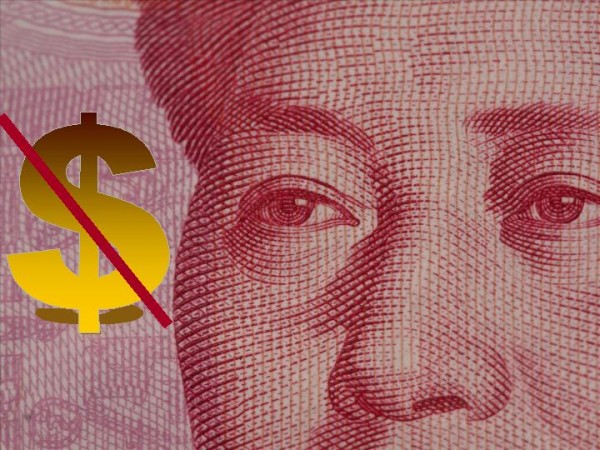 The Chinese economy was, for some time, the beacon of the world economy, posting strong growth and giving a much needed boost to demand in other countries. However, the weakening Chinese economy is now causing serious concerns around the world and not least in China itself.
The Chinese economy was, for some time, the beacon of the world economy, posting strong growth and giving a much needed boost to demand in other countries. However, the weakening Chinese economy is now causing serious concerns around the world and not least in China itself.
China’s stock market on Monday 11th January closed down 5.3%, with the Hong Kong Index down by 2.8%. These falls suggest a continuing downward trajectory this week, following the 10% decline on Chinese markets last week. Today, further falls were caused, at least in part, by uncertainty over the direction of the Chinese currency, the yuan. Volatility in the currency is expected to continue with ongoing depreciation pressures and adding to this is continuing concerns about deflation.
The barrage of bad news on key economic indicators may well mean significant intervention by Chinese authorities to try to avoid its slowest growth in 25 years. However, there are also concerns about China’s ability to manage its economic policy, given recent events. IG’s Angus Nicholson said:
“Global markets are still in the grips of China fears, and it is uncertain whether the Chinese government can do enough to reassure global investors.”
Similar sentiments were echoed by Paul Mackel, head of emerging markets FX research at HSBC:
“Different signals about foreign exchange policy have wrong-footed market participants and we are wary in believing that an immediate calmness will soon emerge.”
Perhaps key to turning this downward trend on its head, will be the Chinese consumers. With a traditionally larger saving ratio than  many Western economies, it may be that this ‘cushion’ will give growth a boost, through the contribution of consumer spending. As we know, aggregate demand comprises consumption, investment, government spending and net exports (AD = C + I + G + X – M). Consumer spending (C) increased from 50.2% in 2014 to 58.4% in 2015, according to HIS Global Insight. A similar increase for 2016 would certainly be welcome.
many Western economies, it may be that this ‘cushion’ will give growth a boost, through the contribution of consumer spending. As we know, aggregate demand comprises consumption, investment, government spending and net exports (AD = C + I + G + X – M). Consumer spending (C) increased from 50.2% in 2014 to 58.4% in 2015, according to HIS Global Insight. A similar increase for 2016 would certainly be welcome.
As oil prices continue to fall and concerns remain over China’s weak economic data, we may well soon begin to see just how interdependent the world has become. Many economists suggest that we are now closer to the start of the next recession than we are to the end of the last one and this latest turmoil on Chinese stock markets may do little to allay the fears that the world economy may once again be heading for a crash. The following articles consider the Chinese turmoil.
Free lunch: China’s weakest link Financial Times, Martin Sandbu (11/01/16)
China’s stocks start the week with sharp losses BBC News (11/01/16)
China shares fall 5% to hit-three-month low The Guardian (11/01/16)
China’s resilient shoppers face fresh test from market headwinds Bloomberg (11/01/16)
China shares head lower again on price data Sky News (11/01/16)
U.S., European shares slip as China, oil woes continue Reuters, Lewis Krauskopf (11/01/16)
U.S. stocks drop as oil tumbles again Wall Street Journal (11/01/16)
China escalates emergency stock market intervention The Telegraph, Mehreen Kahn (05/01/16)
Questions
- How are prices and values determined on the stock market?
- Share prices in China have been falling significantly since the start of 2016. Has it been caused by demand or supply-side factors? Use a demand and supply diagram to illustrate this.
- Why has the volatility of the Chinese currency added further downward pressure to Chinese stock markets?
- With the expected increase in consumer spending in China, how will this affect AD? Use a diagram to explain your answer and using this, outline what we might expect to happen to economic growth and unemployment in China.
- Why are there serious concerns about the weak level of inflation in China? Surely low prices are good for exports.
- Should the world economy be concerned if China’s economy does continue to slow?
- To what extent are oil prices an important factor in determining the future trajectory of the world economy?
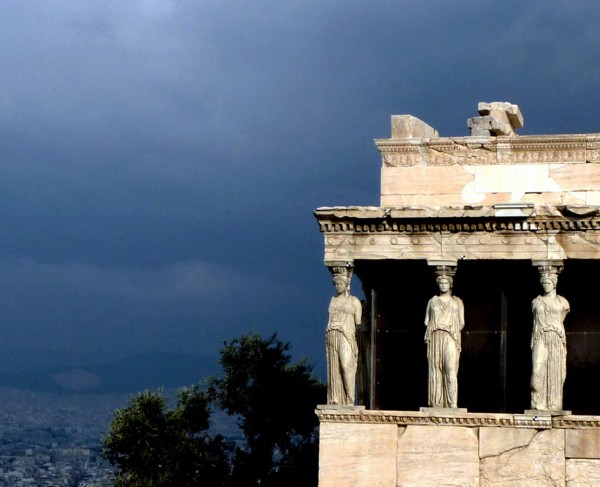 As we saw in several posts on this site, last year was a tumultuous one for the Greek people and their economy. The economy was on the verge of bankruptcy; the Greek people rejected the terms of a bailout in a referendum; exit from the eurozone and having to return to the drachma seemed likely; banks were forced to closed at the height of the crisis; capital controls were imposed, with people restricted to drawing €60 a day or €420 a week – a policy still in force today; unemployment soared and many people suffered severe hardship.
As we saw in several posts on this site, last year was a tumultuous one for the Greek people and their economy. The economy was on the verge of bankruptcy; the Greek people rejected the terms of a bailout in a referendum; exit from the eurozone and having to return to the drachma seemed likely; banks were forced to closed at the height of the crisis; capital controls were imposed, with people restricted to drawing €60 a day or €420 a week – a policy still in force today; unemployment soared and many people suffered severe hardship.
To achieve the bailout, the Syriza government had to ignore the results of the referendum and agree to harsh austerity policies and sweeping market-orientated supply-side policies. This, at least, allowed Greece to stay in the eurozone. It held, and won, another election to seek a further mandate for these policies.
 But what are the prospects for 2016? Will it be a year of recovery and growth, with market forces working to increase productivity? Does 2016 mark the beginning of the end and, as prime minister Alexis Tsipras put it, “a final exit from economic crisis”?
But what are the prospects for 2016? Will it be a year of recovery and growth, with market forces working to increase productivity? Does 2016 mark the beginning of the end and, as prime minister Alexis Tsipras put it, “a final exit from economic crisis”?
Or will the continuing cuts simply push the economy deeper into recession, with further rises in unemployment and more and more cases of real human hardship? Is there a hysteresis effect here, with the past six years having created a demoralised and deskilled people, with cautious investors unable and/or unwilling to rebuild the economy?
 The article below looks at the rather gloomy prospects for Greece and at whether there are any encouraging signs. It also looks at the further demands of the troika of creditors – the IMF, the ECB and the European Commission’s European Stability Mechanism (ESM) – and at what the political and economic impact of these might be.
The article below looks at the rather gloomy prospects for Greece and at whether there are any encouraging signs. It also looks at the further demands of the troika of creditors – the IMF, the ECB and the European Commission’s European Stability Mechanism (ESM) – and at what the political and economic impact of these might be.
Greece’s economic crisis goes on, like an odyssey without end The Guardian, Helena Smith (4/1/16)
Questions
- Construct a timeline of Greece’s debt repayments, both past and scheduled, and of the bailouts given by the troika to prevent Greece defaulting.
- What supply-side reforms are being demanded by Greece’s creditors?
- What will be the effect of these supply-side reforms in (a) the short run; (b) the long run?
- Explain the meaning of hysteresis as it applies to an economy in the aftermath of a recession. How does the concept apply in the Greek situation?
- Discuss the alternative policy options open to the Greek government for tackling the persistent recession.
- Would it be better for Greece to leave the euro? Explain your arguments.
- “I cannot see how this government can survive the reforms. And I cannot see how it can avoid these reforms.” Is there any way out of this apparent impasse for the Greek government?
 To what extent does history repeat itself? Minsky’s Financial Instability Hypothesis infers that credit cycles are fairly inevitable. We have seem them in the past and we will see them in the future. Human beings are subject to emotion, to irrational exuberance and to a large dose of forgetfulness! To what extent do the latest UK credit numbers suggest that we might be embarking on another credit binge? Are the credit data consistent with evidence of another credit cycle?
To what extent does history repeat itself? Minsky’s Financial Instability Hypothesis infers that credit cycles are fairly inevitable. We have seem them in the past and we will see them in the future. Human beings are subject to emotion, to irrational exuberance and to a large dose of forgetfulness! To what extent do the latest UK credit numbers suggest that we might be embarking on another credit binge? Are the credit data consistent with evidence of another credit cycle?
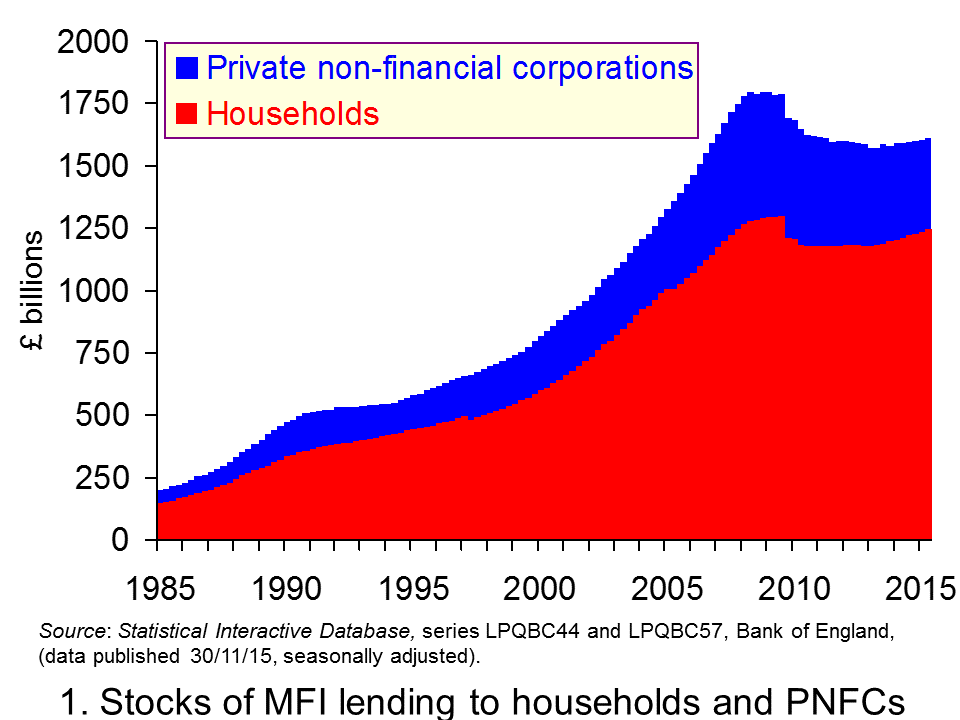 Chart 1 shows the stocks of debt acquired by households and private non-financial corporations from MFIs (Monetary Financial Institutions). The scale of debt accumulation in the late 1980s and again from the mid 1990s up to the financial crisis of the late 2000s is stark. At the start of 1985 the UK household sector had debts to MFIs of around £140 billion. By the start of 2009 this had hit £1.29 trillion. Meanwhile, private non-financial corporations saw their debts to MFIs rise from around £45 billion to over £500 billion. (Click here to download a PowerPoint of the chart.)
Chart 1 shows the stocks of debt acquired by households and private non-financial corporations from MFIs (Monetary Financial Institutions). The scale of debt accumulation in the late 1980s and again from the mid 1990s up to the financial crisis of the late 2000s is stark. At the start of 1985 the UK household sector had debts to MFIs of around £140 billion. By the start of 2009 this had hit £1.29 trillion. Meanwhile, private non-financial corporations saw their debts to MFIs rise from around £45 billion to over £500 billion. (Click here to download a PowerPoint of the chart.)
The path of debt at the start of the 2010s is consistent with a story of consolidation. Financially-distressed households, private non-financial corporations and, of course, MFIs themselves meant that corrective action was needed to repair their balance sheets. The demand for and supply of additional credit waned. Debt accumulation largely ceased and, in fact, debt numbers fell. This trend continues today for private non-financial corporations. But, for households debt accumulation resumed in the middle of 2013. At the end of the third quarter of 2015 the household sector had debt obligations to MFIs of £1.246 trillion.
 Chart 2 focuses on flows rather stocks. It allows us to see the accumulation of new credit (i.e. less repayments of debt). What is even more apparent from this chart is the evidence of cycles in credit. The growth in new credit during the 2000s is stark as is the subsequent squeeze on credit that followed.
Chart 2 focuses on flows rather stocks. It allows us to see the accumulation of new credit (i.e. less repayments of debt). What is even more apparent from this chart is the evidence of cycles in credit. The growth in new credit during the 2000s is stark as is the subsequent squeeze on credit that followed.
The question that follows is what path are we now on? Clearly flows of credit to households are again on the rise. In part, this is driven by the rebound in the UK housing market. But, in fact there is a more rapid increase in consumer credit, i.e. unsecured debt. (Click here to download a PowerPoint of the chart.)
 Chart 3 shows the flows of consumer credit from MFIs and other credit providers. Again, we see the marked evidence of cycles. In the year to the end of Q1 of 2015 net consumer credit flows amounted to £22.8 billion, the highest figure since the 12-month period up to the end of Q3 of 2005. Click here to download a PowerPoint of the chart.)
Chart 3 shows the flows of consumer credit from MFIs and other credit providers. Again, we see the marked evidence of cycles. In the year to the end of Q1 of 2015 net consumer credit flows amounted to £22.8 billion, the highest figure since the 12-month period up to the end of Q3 of 2005. Click here to download a PowerPoint of the chart.)
While it might be a little early to say that another Minsky cycle is well under way, policymakers will be keeping a keen eye on credit patterns. Is history repeating itself?
Articles
Average UK mortgage debt rises to £85,000 The Guardian, Phillip Inman (15/12/15)
Consumer spending rise troubles Bank of England The Guardian, Heather Stewart (24/11/15)
Recovery ‘too reliant on consumer debt’ as BCC downgrades forecast The Guardian, Heather Stewart (9/12/15)
BCC: UK Growth Too Reliant On Consumer Debt Sky News (9/12/15)
Interest rates will stay low for longer – but household debt is a worry, says BoE The Telegraph, Szu Ping Chan (24/11/15)
IMF: UK’s economic performance ‘very strong’, but risks remain BBC News (11/12/15)
Data
Bankstats (Monetary and Financial Statistics) – Latest Tables Bank of England
Statistical Interactive Database Bank of England
Questions
- How can the financial system affect the economy’s business cycle?
- What does it mean if households or firms are financially distressed? What responses might they take to this distress and what might the economic consequences be?
- How would you measure the net worth (or wealth) of an individual or a firm? What factors might affect their net worth?
- How might uncertainty affect spending and saving by households and businesses?
- What does it mean if bank lending is pro-cyclical?
- Why might lending be pro-cyclical?
- Are there measures that policymakers can take to reduce the likelihood that flows of credit become too excessive?
 In the blog the service sector continues to drive the UK business cycle written in October 2014 we observed how UK growth was being driven by the service sector while other industrial sectors struggled. The contrasting performance across UK industry appears now to be even more marked. The latest GDP numbers from the Office for National Statistics contained in Gross Domestic Product: Preliminary Estimate, Quarter 4 (Oct to Dec) 2015 show the economy’s output expanded by 0.5 per cent in the fourth quarter. Yet the construction sector is in recession following contractions of 1.9 per cent (Q3) and 0.1 per cent (Q4). Here we update our earlier blog to evidence the UK’s growth paradox.
In the blog the service sector continues to drive the UK business cycle written in October 2014 we observed how UK growth was being driven by the service sector while other industrial sectors struggled. The contrasting performance across UK industry appears now to be even more marked. The latest GDP numbers from the Office for National Statistics contained in Gross Domestic Product: Preliminary Estimate, Quarter 4 (Oct to Dec) 2015 show the economy’s output expanded by 0.5 per cent in the fourth quarter. Yet the construction sector is in recession following contractions of 1.9 per cent (Q3) and 0.1 per cent (Q4). Here we update our earlier blog to evidence the UK’s growth paradox. Chart 1 shows quarterly economic growth since 1980s (Click here for a PowerPoint of the chart). It illustrates nicely the inherent volatility of economies – one of the threshold concepts in economics.The average quarterly rate of growth since 1980 has been 0.5 per cent so on the face of it, a quarterly growth number of 0.5 per cent might seem to paint a picture of sustainable growth. Yet, the industrial make up of growth is far from balanced.
Chart 1 shows quarterly economic growth since 1980s (Click here for a PowerPoint of the chart). It illustrates nicely the inherent volatility of economies – one of the threshold concepts in economics.The average quarterly rate of growth since 1980 has been 0.5 per cent so on the face of it, a quarterly growth number of 0.5 per cent might seem to paint a picture of sustainable growth. Yet, the industrial make up of growth is far from balanced.  Consider now Chart 2 (Click here for a PowerPoint of the chart). It allows us to analyse more recent events by tracking how industrial output has evolved since 2006. It suggests an unbalanced recovery following the financial crisis. In 2015 Q4 the economy’s total output was 6.6 per cent higher than in 2008 Q1 with service-sector output 11.6 per cent higher. However, a very different picture emerges for the other principal industrial types.
Consider now Chart 2 (Click here for a PowerPoint of the chart). It allows us to analyse more recent events by tracking how industrial output has evolved since 2006. It suggests an unbalanced recovery following the financial crisis. In 2015 Q4 the economy’s total output was 6.6 per cent higher than in 2008 Q1 with service-sector output 11.6 per cent higher. However, a very different picture emerges for the other principal industrial types.









